Antarctic Infrastructure and Logistics (AIL)
ANTARCTIC SCIENCE AND ENGINEERING SUPPORT CONTRACT RESOURCE LIBRARYInformation in the Antarctic Science and Engineering Support Contract Resource Library is for reference purposes. Nothing in this material should be construed as a firm requirement and the Government does not guarantee that the information provided is the most current. Material contained at this website is NOT a substitute for information provided on the Request for Information: Antarctic Science and Engineering Support Contract (USAP_RFI_02). If you are having trouble accessing any of these documents, contact the Office of Polar Programs. |
ANTARCTIC NEWS
United States Antarctic Program Web Portal — Visit the USAP portal for information on U.S. program activities.
ANTARCTIC STATIONS
The U.S. Antarctic Program, Antarctic Infrastructure and Logistics Section, operates three year-round stations—McMurdo, Amundsen-Scott South Pole, and Palmer stations. Camps operate only in summer to support field research. Automated geophysical observatories and more than 100 automated weather stations operate year-round. The weather stations involve international collaboration with the Italian, German, Australian, and British programs.
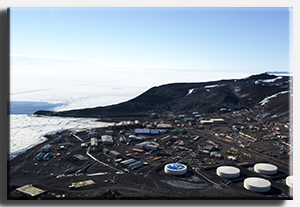
McMurdo Station, Ross Island, is the largest station in Antarctica and the logistics hub for the U.S. Antarctic Program. It supports three landing areas for aircraft and has an ice pier for ship offload. (NSF photo by Peter Rejcek.) Visit the McMurdo Station webcam. Read recent reports from McMurdo Station, published in the Antarctic Sun. |
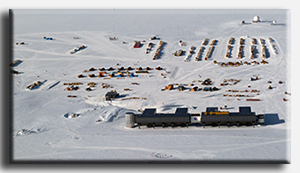
Amundsen-Scott South Pole Station, geographic South Pole, Antarctica, February 2012. (NSF photo by Jesse Peterson) NSF Special Report — U.S. South Pole Station: Supporting Science Visit the South Pole webcam. Read recent reports from South Pole Station, published in the Antarctic Sun. |
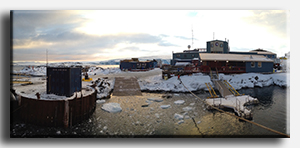
Palmer Station, Anvers Island, Antarctic Peninsula Region, Antarctica. (NSF/USAP photo by Jeffrey Kietzmann, Raytheon Polar Services) Visit the Palmer Station webcam. Read recent reports from Palmer Station, published in the Antarctic Sun. |
LOGISTICAL SUPPORT
|
Ski-equipped Hercules airplanes (LC-130) transport fuel, equipment, supplies, and personnel from McMurdo Station to inland sites, including Amundsen-Scott South Pole Station, and from New Zealand. During the austral summer, wheeled military transports (C-17s and C-130s) also bring equipment, personnel, and supplies to Antarctica from New Zealand.
Ski-equipped Twin Otters and Basler aircraft also provide support to field teams during the austral summer. |
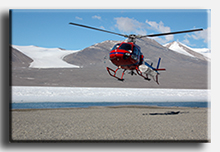
Helicopters provide support to field parties in the McMurdo Dry Valleys in southern Victoria Land and at remote field camps. Here a helicopter lands near the Beardmore Camp in the Transantarctic Mountains. (NSF photo by Peter Rejcek) |

The U.S. Antarctic Program operates one icebreaking research ship, the Nathaniel B. Palmer. Icebreakers annually open a channel to McMurdo Station to enable a supply ship and a tanker to reach the station. |
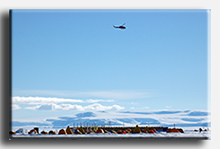
Small and large field camps support science parties in remote areas of Antarctica. The photograph shows a large camp—Central Transantarctic Mountains Camp—which supported field projects during the 2010-2011 austral summer season. (NSF photo by Peter Rejcek) |
 Automated Geophysical Observatories supported by the U.S. Antarctic Program. Automated Geophysical Observatories supported by the U.S. Antarctic Program.
|


